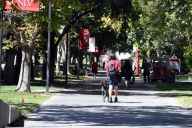You have /5 articles left.
Sign up for a free account or log in.
This story has been updated.
Controversial posters on immigration have rattled residents of one Stanford University dormitory. And university administrators, who have been zealous in their support of free speech rights, seem to have softened, removing one flier even while later admitting it should have remained hanging.
Generally, as a private institution, Stanford would have more leeway in dictating rules on free expression, except it’s subject to California’s unique Leonard Law, which applies the First Amendment even to private, secular colleges. Plus, the university has repeatedly stressed that it believes in protecting the right to share controversial ideas.
In December, one student posted a flier to her dormitory door advertising a hotline to report any local activity of U.S. Immigration and Customs Enforcement. It was ripped down and replaced with a poster bearing the rallying cry of President Trump: “#BuildTheWall.”
The staffers in the dormitory, Kimball Hall, reported the incident as an “act of intolerance.”
Last month, it happened again. The same poster warning of ICE, after being replaced, was torn off the same door. This time, three students -- Araceli Alicia Garcia, Mayahuel Victoria Ramírez and Jessica Reynoso -- mobilized and printed out 200 of the bright-yellow fliers with the hotline number and papered them all over the dormitory.
“The ‘#BuildtheWall’ message was targeted at one resident in particular because of their ethnicity, and their belief that deportations are cruel and separate families,” the students wrote in an opinion piece in the student-run Stanford Daily newspaper. “However, as Latinas in Kimball and on this campus in general, we also heard the aggressor’s message loud and clear. We are now acutely aware that there are people on this campus that not only despise our presence, but would also target and attack us through intimidating acts and speech.”
In late January, another student, Isaac Kipust, decided to satirize the original leaflet with a political message of his own. The original read “Protect our community, report ICE activity.”
Kipust’s twist: “Protect our community, report legitimate law enforcement activity!”
“Call to receive immediate support if you see law enforcement authorities doing their job. Beloved community criminals deserve protection from Trump’s tyranny.”
These, too, were eventually removed at the university’s direction. Kipust, according to an op-ed he wrote in the student publication The Stanford Review, expected that his free speech rights would be supported when he met initially with Stanford representatives as well as Garcia, Ramírez and Reynoso.
Instead, as Kipust tells it, because of “the three crying students at the table, I was not permitted to repost my flyers.”
“I was told that feelings trumped my right to express speech others might find objectionable,” Kipust wrote. “The fact that my flyers were censored because they made students cry stunned me. If speech’s impact mattered more than its content, then the possibilities for censorship were limitless. For instance, at the meeting, the other students -- some university staff -- were visibly emotional. I was not. Emotions are too subjective a criterion for some arguments to be accepted and others denied.”
This account of the meeting matches that of the three other students, though they describe Kipust as lacking empathy. They also write that Stanford faculty and staff “are not being taught the necessary skills to help facilitate meaningful dialogue about race and ethnicity.”
Campus residences operate under their own rules, meaning the residents there can collectively decide whether to allow fliers or not, said spokesman E. J. Miranda. An interim policy has been instituted at Kimball making clear that all students, "regardless of perspective," have the right to hang fliers, Miranda said.
"We intend to engage the broader residential community through spring quarter in order to develop a system wide flyer policy for the next school year," Miranda wrote in an email.
The decision barring Kipust’s posters in the dormitory was later reversed by Lisa De La Cruz Caldera, lead residence dean at Stanford.
Kipust had met with her, armed with an opinion from Michael W. McConnell, Richard and Frances Mallery Professor and director of the Constitutional Law Center at the Stanford Law School.
McConnell agreed with Kipust -- Stanford couldn’t block Kipust’s posters simply because they offended others in the dormitory.
“To allow a political message on one side of a controversial public issue and to disallow a message taking the opposite position is a blatant example of viewpoint discrimination, which is not only contrary to Stanford’s commitment to academic freedom but also to California law. If the university does not promptly reverse the decision of the dorm administrators and redress this situation, there is a serious risk of legal liability as well as public embarrassment to the university,” McConnell wrote in an email to Kipust.
Stanford president Marc Tessier-Lavigne has ardently defended the need for campus free expression, though the kerfuffle over the fliers has demonstrated how the free speech debate at Stanford, and other institutions, can be more complicated than administrators initially realize.
Other college presidents, though, such as at the University of Chicago, have taken similar hard-line stances on free speech.
Back in November -- stemming from a digital war of words between some Stanford students and anti-Islam extremist Robert Spencer -- Tessier-Lavigne released a lengthy statement on free expression with Provost Persis Drell before Spencer visited the campus.
The administrators wrote that freedom of expression was fundamental to the university’s mission, but balancing this with an inclusive campus culture could prove challenging at times. Some students could be “deeply wounded” and “frightened” by certain speech, they wrote.
“We worry about the experiences of vulnerable or silenced populations within our community -- those who seek an environment where their identities are welcomed, not challenged by hate or ignorance. We cannot dismiss their concerns, and we certainly don’t want them to remain silent. Instead we must continually find ways of providing meaningful support.”
Drell posted another statement on free speech Tuesday, writing that what some students intend to be free expression of ideas my hurt individuals.
The great opportunity of being at a place like Stanford is to have our horizons broadened, our insights deepened, our discoveries enriched through interaction with those who bring different histories and different perspectives. We can only do this if we engage with each other with interest and respect.
Respect, I believe, requires acknowledging the impact that actions and words can have for other members of our community. Members of our historically underrepresented or marginalized populations can feel vulnerable and under physical threat from actions and words that might be neutral or only mildly uncomfortable to another. Individuals with opinions that don’t conform with the majority can feel isolated or unheard. As members of this community, countering cruel, insensitive or biased speech, and recognizing the damage it may be inflicting on others, is another facet of responsibility that we all need to embrace.
The Foundation for Individual Rights in Education, a civil liberties watchdog group in academe, also called on Stanford to support free speech rights.
“Tearing down flyers due to their content is antithetical to Stanford's commitment to protecting free speech on campus,” Zachary Greenberg, Justice Robert H. Jackson legal fellow at FIRE, said in a statement. “A university committed to upholding First Amendment principles should encourage students to speak out against speech they dislike. This includes expression that may be subjectively considered hateful, intolerant, or offensive.”








